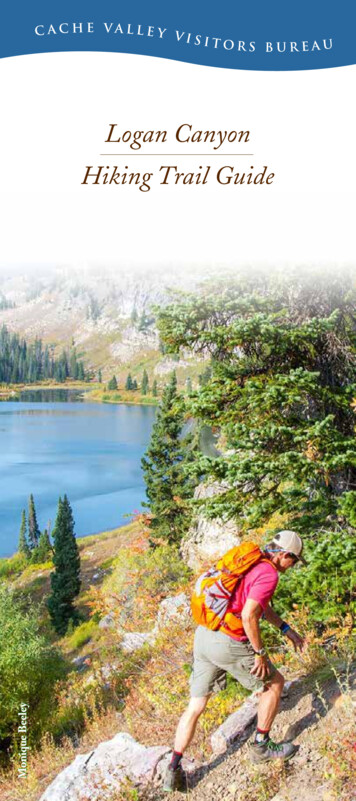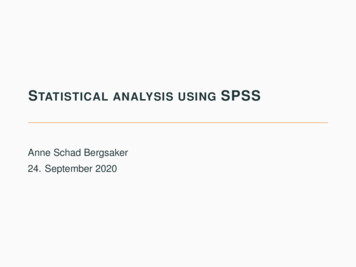
Transcription
Cache Valley Visitors BureauGet to KnowLo ga n ’s H is tori cMa in StreetA 45 Minute Self-Guided Walking TourCache Valley Visitors ley.comWritten by Gary N. AndersonThanks to Utah State University Special Collectionsand the Cache County Historical Commission.
Logan was not the first White settlement in NorthernUtah’s Cache Valley, but because of its strategic locationand ample water it grew rapidly after its founding in 1859into a bustling city, and a business, educational, politicaland religious center. The Shoshone Indians called the region“the house of the Great Spirit” long before fur trappers cameseeking beaver pelts in the early 1800s. Early maps called itWillow Valley and the mouth of the canyon east of here wascalled Logan’s Hole (Ephraim Logan was a trapper). TheLogan River flows from the canyon, but at one point duringthe Pleistocene period it was a tributary to the mighty LakeBonneville, which once was 650 feet deep above Logan’sMain Street.Walking Tour Map ofLogan’s Historic Main Street12Federal Avenue1434100 NorthCac h e Co u nt y Co u rth o u se195 North Main StreetUSU Special Collections1The Courthouse was renovated in 2005.The CacheCountyCourthousewas built in1883 at a costof 17,814.79by theUnited OrderManufacturingand Building1211Main Street135Center Street106798H istoric Main Street Circa 1900As you stand in front of the Tabernacle (Site No. 5), facing MainStreet, you can compare the drawing below showing the street asit appeared in 1900.You may start your walking tour at site 1 (Cache CountyCourthouse) or at any other site. The tour should take you 45minutes not counting browsing and window shopping. Logan’shistoric main street was first surveyed in the 1860sAlso, the American West Heritage Center on U.S. Hwy.89-91 south of Logan allows you to step back through100 years of American West history. It features theJensen Historical Farm, a 1917 working farm and manyhands-on activities and exhibits.
The ostensible reason for the establishment of thecooperative movement was to protect the local economyfrom outside influences brought in by the completion ofthe Transcontinental Railroad. The plan, as introduced,called for the formation of a giant wholesale store inSalt Lake City, with retail cooperatives in outlyingsettlements. The Latter-day Saints (Mormons) wereexpected to patronize only these church-sponsoredoutlets and, in turn, the retail stores would only dealwith the Salt Lake wholesale store. This form ofmerchandising declined in the 1880s and finally theLogan Z.C.M.I. disbanded in 1900. The buildingsuffered a major fire and survived to house FirstNational Bank of Logan on the north, and Woolworth’son the south side. The bank was acquired later by alarger bank based in Salt Lake City.USU Special Collections14Cac h e Valley Ba nk(Lo g an H a ll )101 North Main StreetAcross thestreet whereCache ValleyBank is locatedwas originallyLogan’s SocialHall, the siteof numerousdancesAn example of sensitive restoration.and othercommunity activities in the early days. Then it servedas a hotel and a drugstore. In the 1860s the site wasused for large religious gatherings in the winter, whileresidents met in willow boweries in the summermonths. It, like many Main Street buildings, has serveda variety of functions.These are some bits and pieces of an interesting historythat still can be felt and sometimes seen on Logan’sMain Street. Hopefully you can understand thiscommunity a little better. There are a number of homesin the residential district that also have stories to tell.Company of Logan and renovated in 2005. Thisbuilding is the oldest county building in Utah stillbeing used for its original purpose. The county jailwas in the basement at first, but was later moved toa different location. Even before the constructionof the present building, the old county office washere. It was in a small room in this structure that aman was imprisoned before he was lynched in 1873.Startling as this may sound, Logan was part of theWild West where vigilantes, ruffians, cattle rustlers,and stage coach robbers were part of everyday life.This particular incident took place after the shootingof the sheriff ’s nephew just west of Social Hall whilea Valentine’s dance was in progress. The individualinvolved in the shooting hid out for three days but wasfound and returned to the county office. He was hungfrom the courthouse signpost by an angry group ofmen. Repercussions were felt for years and the DeseretNews summed up the feelings: “From all we can hearwe must believe him to be a murderer and his lifevirtually forfeited to the law, but that did not empowerirresponsible and unauthorized persons to inflictpunishment upon him without due process of law, evenwhen that punishment was undoubtedly deserved.”2Cach e Chamber ofCommerce (Hall of Just ic e )160 North Main StreetThe Cache Chamber of Commerce building wasoriginally known as the Federal Building, which iswhy the road directly south of the building is calledFederal Avenue. The building was first built for U.S.Government functions and also served as the post office.
A flavor of what the Valley was like in the earlydays of settlement can be found in the Daughters ofUtah Pioneers Museum located in what used to be thecourtroom in the Chamber of Commerce building.Over the years people have donated items of interestto the museum in hope that succeeding generationsmay gain appreciation for the struggles and successes ofthe early settlers. The museum is open from MemorialDay to Labor Day or by special appointment. You canimagine yourself stepping back 100 years in time at thishistoric spot.USU Special Collections12Bluebird Restauran t19 North Main StreetThe Bluebird Restaurant nextdoor first began in 1914 and hasbeen in its present location since1923. Stepping inside takesyou back to that era with itsimported marble soda fountainand early pictures of Loganmounted on its walls. TheBluebird has been a gatheringStep into the past for dinner. place for generations of Loganresidents and a source ofmemories for those who return after years away.13USU Special CollectionsUSU Special CollectionsThe buildingthen served asthe DistrictCourt and theCounty Clerk’soffice. In earlydays it was theentrance toTithing Square,which includedOriginally known as the Federal Building.a barn andstock shed, a corral and feed lot, haystacks, granaries,root cellars, a tool shed, workshop, lumberyard, andtithing store. Each Mormon settlement in the Valleyhad a tithing house that was the center of communityeconomic life throughout the 1860s. The inhabitantswere expected to contribute 10 percent of their increaseto the Church. Tithing Square was the central agencyfor receipt and expenditure in the form of produce,livestock, and sometimes cash.P erry, Malmberg, & P erry(Lo gan ’s Bran ch of ZCMI )99 North Main StreetProceedingalong MainStreet youwill passother historiclocations, butnone morehistoric thanLook south to compare with today’s skyline.the buildinghousing Perry, Malmberg, & Perry. This once was thelocation of the Cache Valley branch of Z.C.M.I. Thisabbreviation stands for Zion’s Cooperative MercantileInstitution, which was started by Brigham Young in thelate 1860s and spread to Cache Valley in 1872.
Co pp i n ’ s Ha ll m a rk( J. R . Edward s Sa lo o n)15 North Main StreetAt the location ofCoppin’s Hallmark lookup at the name of J.R.Edwards, preservedin stone above thesecond story windows.Here in 1895, at whatwas Logan’s finestsaloon and billiard hall,the president of theAgricultural Collegeof Utah confrontedOne of several saloons from years past.proprietor Edwardsbecause students from his college were frequentingthe premises. After an exchange of stinging letters,President Joshua Paul took action and after enteringthe hall was struck on the back of the head by one J.R.Edwards. After being fined 5 for assault, Edwardsdid post notices to exclude minors and President Paulreturned to his more mundane duties on College Hill.3USU Special CollectionsUSU Special Collections11Traveling south alongMain Street you willcome to what is now theZions Bank building.This used to be the cornerof Tithing Square andhas a very interestingsculptural depiction abovethe door of the bank.The Tithing Office faced TabernacleThe trappers and IndiansSquare in 1904.are typical of those early dwellers who cached furs andother items near riverbanks in what is permanentlyknown as Cache Valley. Jedediah Smith and Jim Bridgerare two of the more famous trappers who traversedthe Valley caching supplies after the rendezvous in thesummer and exchanging them with beaver pelts in thewinter. A favorite spot for the trappers was along theLogan River, a few blocks south of here. Around thecorner where the drive-up window is located was theTithing Office.4Logan is the county seat because it grew more rapidly thanother towns in the area. The city’s dirt streets and log cabinshave changed to pavement and imposing brick structures.Zion s Ban k(LDS T i th in g Sq uare)102 North Main StreetSt. John ’s Ep iscopal Ch urc h69 East 100 NorthOne block east of the bank is St. John’s EpiscopalChurch, which was renovated in 2004. Very few nonMormon settlers lived in Logan in the first 10 yearsof its existence, but the first Protestants to establish acongregation were the Episcopalians who also set up aschool in 1873. Other denominations including
USU Special Collections5LDS Ta b ernacle50 North Main StreetThis auspiciousbuildingknown as theTabernaclewas renovatedto reflect itsoriginal interiorand colors.Constructionof this structureThis picture looks east with the Templein the background.commencedbefore construction of the Temple began but wasfinished after the completion of the Temple. It has10USU Special CollectionsUSU Special CollectionsMethodists,Congregationalists, andPresbyterianssent missionaries andschoolteachersafter that. Twoblocks eastyou can seeThe church in 1915.the MormonTemple, which was completed in 1884 on the site wherethe Shoshone performed healing ceremonies longbefore the arrival of the White man. While only worthyMormon church members can enter the Temple, theLogan Tabernacle southwest of St. John’s is accessibleto everyone.Cain e Ly ric Th eatre28 West Center StreetThe third buildingto the east alongCenter Street isthe Caine LyricTheatre originallybuilt by the Thatcherfamily in 1913. It ispurported to be theresidence of a friendlyghost who is partialto Shakespeare.The theatre wasHome of Logan’s friendly theatre ghost.refurbished and anew wing was added in 2001. The theatre is operated byUtah State University and during the summer is hometo the Old Lyric Repertory Company. The ghost, whoappears on the edge of the balcony in Elizabethan garbwearing a fool’s cap, has been heard laughing duringrehearsals of Hamlet. Before returning to Main Streetyou may want to head back down to 75 West CenterStreet to the Bluebird Candy Company, which has beenmaking traditional handmade chocolates since 1914.This was originally the location of the Palace Hotel andthe stagecoach and livery stable that serviced downtown.Returning to the Wells Fargo Bank corner, cross CenterStreet and pass the Budge corner, once the home of theBudge Clinic and Walgreen Drug.
Railroad. It was a local rail line connecting downtownwith the campus of Utah State Agricultural College(now Utah State University) and was also connectedwith lines to the south in Ogden and to the northin Preston, Idaho. From 1914 to the mid-1920s therailroad prospered, but it succumbed to an agriculturaldepression and the increased use of trucks andautomobiles. It was finally abandoned in 1946. Fromthis corner look across the street to the south whereyou can see the site of the Cache Knitting Mills, whichin 1876 was the site of the United Order FoundryMachine and Wagon Manufacturing Company.T h atc h er Mi ll35 West 100 SouthTurning tothe west youwill pass alarge brownVictorian housewith whitetrim that oncewas the homeof GeorgeW. ThatcherThis and other canals provide water for irrigation.and BrighamYoung, Jr. This house was renovated in 2001 and ishome to the Alliance for the Varied Arts. On the leftyou can see what remains of the Thatcher Milling andElevator Company, which in 1888 had the capacity tomill 1,100 bushels of grain per day. By turning right onthe drive into the mid-block parking lot you will pass bythe rear of the Eccles Theatre and through the drive-infor Wells Fargo Bank.6USU Special CollectionsUSU Special Collections9been the site of many public and church meetingsover the years. It was built primarily by volunteerlabor over more than 25 years. A number of famouspeople have spoken from the pulpit including bothreligious and political leaders. It was also the placewhere other exciting cultural events took place. In the1870s and 1880s the women’s Relief Society took onvarious projects including silk culture, the manufactureof hats, basket-making, broom-making, and sewing.One Sunday Priscilla Jacobs had to depart prematurelyfrom a meeting in the Tabernacle when the silk wormsshe was keeping warm in a small bag around her neckstarted to hatch. She was followed closely out the doorby the men who had agreed to gather mulberry leaveson which to feed the worms.Wells Fargo BANK( Thatch er Op era H ouse)5 South Main StreetThe streetsouth ofTabernacleSquare is nowknown asCenter Streetand it was thelocation of thefirst housesbuilt in Logan.Fire destroyed the bank and opera house in 1912.In June of 1859a group of Mormon settlers first started to construct aseries of log cabins facing each other in “fort style” alongCenter Street for two blocks, west of Main Street. By
October the fort was three blocks long. These houseshad dirt roofs and floors and there are some accountsthat recall taking umbrellas to bed to keep the rainoff. The Wells Fargo Bank stands on the site of theThatcher Brothers Bank and Opera House constructedin 1890. The Opera House could seat 800 people onthe second level of the building. Many professionaland local groups performed there in theater and operaproductions. Many other types of entertainment as wellas political and civic gatherings continued here until theafternoon of April 17, 1912, when fire broke out in thebasement and progressed until it destroyed the structure.The headline in the Logan Journal was “Worst Fire inCache Valley History,” and in much smaller type wasnews of the sinking of the Titanic, with 1,300people aboard.Ellen Eccles Th eatre( Ca p i to l Th eatre)43 South Main StreetGeorge W.Thatcher andsome associatesdecided thatLogan neededa grand theatreand some 11years later theCapitol Theatrewas completedThis 1923 theatre was reopened in 1993after extensive renovation.just south of thebank. In its day it was one of the finest facilities of itskind. Since the mid-1950s it had been used primarily8F uhriman ’s Framin g& Fin e Art (U tah-Idah oCen tral Railroad)75 South Main StreetDarrin SmithCraig Law7for movies, but it was purchased by the city. Underthe direction of the Capitol Arts Alliance, a nonprofitcorporation, the theatre underwent a 6.4 millionrenovation in 1993 and is being managed by the CacheValley Center for the Arts for the benefit of the entireregion. Now known as the Ellen Eccles Theatre, itboasts the only full-size stage and fly loft in the area andthe ornate interior has been restored in a spectacularfashion that amazes visitors from near and far. Besidespresenting a wide variety of musical and theatricalperformances year-round that have revived memoriesof earlier days, the theatre is now the home of UtahFestival Opera, which presents a series of world-classoperas during the summer months. Two valuableadditions to the theatre are the Bullen Center andThatcher-Young Mansion, which house an art gallery,artist in residence, ceramics studio, dance rooms, and avariety of dance and theatre classes.Waiting for the train in 1919.Continuingto the cornerwhereFuhriman’sGallery is nowlocated, you arestanding at thelocation of theUtah-IdahoCentral
Logan Z.c.M.i. disbanded in 1900. the building suffered a major fire and survived to house first national Bank of Logan on the north, and Woolworth's on the south side. the bank was acquired later by a larger bank based in salt Lake city. CaChe Valley bank (logan hall) 101 North Main Street across the street where cache Valley Bank is located










